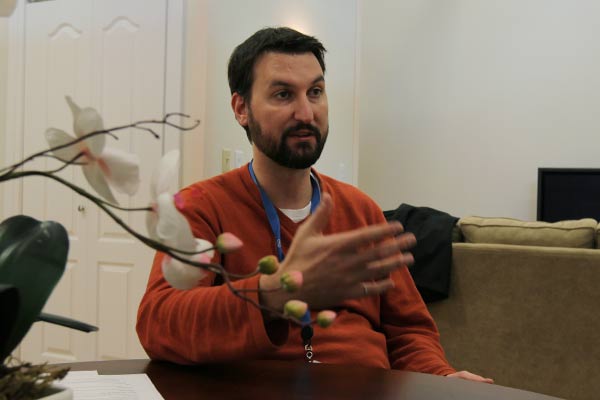
This House Knows When You Need Help
Published: November 22, 2011
Located on the 12th floor of the Toronto Rehabilitation Institute-University Health Network is a new home.
Actually, it’s HomeLab, a fully functioning one bedroom, single-storey smart home testing site.
The lab’s director, Alex Mihailidis, is a professor in occupational science and occupational therapy and the Institute of Biomaterials and Biomedical Engineering. He said HomeLab was built to develop and test new tools that will help aging adults overcome the challenges they face in their own homes.
“Our research focuses on easing the burden of caregivers and increasing the independence and safety of people with disabilities,” said Mihailidis.
A catwalk surrounds the house so researchers can observe subjects in the home from overhead. A suspended grid enables his team to test devices, such as overhead lifts and ceiling-mounted monitoring systems. They also do research on basic items, such as grab bars and handrail designs for stairs.
“This space allows us to do biomechanical research -- studying how family caregivers transfer loved ones from the toilet or in and out of the bathtub -- in addition to our smart home and high-tech artificial intelligence work,” said Mihailidis.
Helper: An Autonomous Health and Wellness Monitoring and Emergency Response System.
Mounted on the ceiling between the dining area and living room is a unit called Helper: An Autonomous Health and Wellness Monitoring and Emergency Response System.
Helper is slightly larger than a smoke detector and can sense when someone in the home has fallen. It differs from the typical personal response systems in many ways. First, it doesn’t require people to wear a push button device nor does it depend on the users to activate it when they’re in trouble. It uses a vision sensor (i.e., a  non-recording video camera), a microphone, speakers and a processor to track a person in her home. If she falls, the system uses speech recognition technology to start a conversation to determine if and what type of assistance she needs.
non-recording video camera), a microphone, speakers and a processor to track a person in her home. If she falls, the system uses speech recognition technology to start a conversation to determine if and what type of assistance she needs.
“The dialogue has been developed to quickly assess the severity of the situation through asking a series of simple yes or no questions,” explained Mihailidis.
Based on the user’s answers the system will determine if help is required, and if so, it automatically sends a message to a predefined list of contacts.
“It monitors movement in the home and is programmed to send a message to up to five family members who are then connected by a conference call so they can co-ordinate a response,” he said. “It can also be programmed to call 911.”
Mihailidis has received the U.S. patent on the system and is currently seeking commercial partners. He noted that Helper will be an affordable system. Unit costs are estimated at $100 each, because it uses off- the-shelf components and a regular Internet connection.
Coach: Intelligent Assistive Daily Living (ADL) Support for Older Adults with Dementia
The HomeLab bathroom looks like any other bathroom in an average home, except for the monitor and camera hanging above the sink.
The unit, called Coach: Intelligent Assistive Daily Living (ADL) Support for Older Adults with Dementia, is a system that helps people with dementia perform personal hygiene tasks.
“It provides reminders to an older adult with Alzheimer’s to do the common kinds of activities they need to complete, such as hand washing and brushing their teeth,” said Mihailidis.
 The system uses artificial intelligence to learn about specific users and tailors its prompts to her habits and abilities. For instance, when some people wash their hands they first turn on the water, wet their hands and then apply soap, whereas some will put soap on before wetting their hands. The system tracks the user and makes adjustments; instead of changing the person’s routine to coincide with a program, the system adjusts itself based on the person’s routine.
The system uses artificial intelligence to learn about specific users and tailors its prompts to her habits and abilities. For instance, when some people wash their hands they first turn on the water, wet their hands and then apply soap, whereas some will put soap on before wetting their hands. The system tracks the user and makes adjustments; instead of changing the person’s routine to coincide with a program, the system adjusts itself based on the person’s routine.
Mihailidis noted that clinical trials with dementia subjects demonstrated a notable (on average, 25 per cent) decrease in caregiver interventions when the device guided hand washing.
He also said that he and his team are looking at ways to develop Coach for the kitchen; in particular how the system can help older adults track and maintain their nutrition intake.
The Future Looks Bright
This past spring Mihailidis’ group received a grant from the Canadian Institutes of Health Research (CIHR) to test personal mobile robots – something that will allow them to integrate all their personal assistive systems into one unit.
The motivation behind the HomeLab research is to make assistive devices seamless and easy to use so older adults can live safely and independently. Mihailidis called them “zero effort technologies.”
To learn more about HomeLab and Mihailidis’ other research projects see his website.



